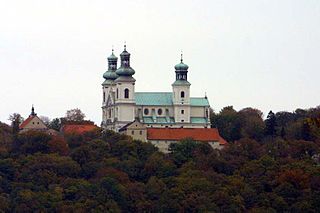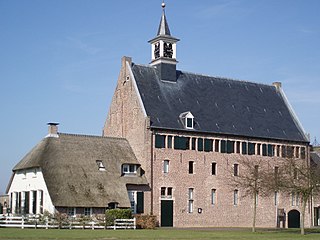Related Research Articles

The Benedictines, officially the Order of Saint Benedict, are a monastic religious order of the Catholic Church following the Rule of Saint Benedict. They are also sometimes called the Black Monks, in reference to the colour of their religious habits. They were founded by Benedict of Nursia, a 6th-century monk who laid the foundations of Benedictine monasticism through the formulation of his Rule of Saint Benedict.

A monastery is a building or complex of buildings comprising the domestic quarters and workplaces of monastics, monks or nuns, whether living in communities or alone (hermits). A monastery generally includes a place reserved for prayer which may be a chapel, church, or temple, and may also serve as an oratory, or in the case of communities anything from a single building housing only one senior and two or three junior monks or nuns, to vast complexes and estates housing tens or hundreds. A monastery complex typically comprises a number of buildings which include a church, dormitory, cloister, refectory, library, balneary and infirmary, and outlying granges. Depending on the location, the monastic order and the occupation of its inhabitants, the complex may also include a wide range of buildings that facilitate self-sufficiency and service to the community. These may include a hospice, a school, and a range of agricultural and manufacturing buildings such as a barn, a forge, or a brewery.

A nun is a member of a religious community of women, typically living under vows of poverty, chastity, and obedience in the enclosure of a monastery. Communities of nuns exist in numerous religious traditions, including Buddhism, Christianity, Jainism, and Taoism.
A religious order is a lineage of communities and organizations of people who live in some way set apart from society in accordance with their specific religious devotion, usually characterized by the principles of its founder's religious practice. The order is composed of laypeople and, in some orders, clergy. Religious orders exist in many of the world's religions.

The Camaldolese Hermits of Mount Corona,, commonly called Camaldolese is a monastic order of Pontifical Right for men founded by Saint Romuald. Their name is derived from the Holy Hermitage of Camaldoli, high in the mountains of central Italy, near the city of Arezzo. Its members add the nominal letters E.C.M.C. after their names to indicate their membership in the congregation.

The Bridgettines, or Birgittines, formally known as the Order of the Most Holy Savior, is a monastic religious order of the Catholic Church founded by Saint Birgitta or Bridget of Sweden in 1344, and approved by Pope Urban V in 1370. They follow the Rule of Saint Augustine. There are today several different branches of Bridgettines.

Canons regular are canons in the Catholic Church who live in community under a rule and are generally organised into religious orders, differing from both secular canons and other forms of religious life, such as clerks regular, designated by a partly similar terminology.
Canoness is a member of a religious community of women living a simple life. Many communities observe the monastic Rule of St. Augustine. The name corresponds to the male equivalent, a canon. The origin and Rule are common to both. As with the canons, there are two types: canonesses regular, who follow the Augustinian Rule, and secular canonesses, who follow no monastic Rule of Life.

Cluny Abbey is a former Benedictine monastery in Cluny, Saône-et-Loire, France. It was dedicated to St Peter.

Augustinian nuns are the most ancient and continuous segment of the Roman Catholic Augustinian religious order under the canons of contemporary historical method. The Augustinian nuns, named after Saint Augustine of Hippo, are several Roman Catholic enclosed monastic communities of women living according to a guide to religious life known as the Rule of St. Augustine. Prominent Augustinian nuns include Italian mystic St. Clare of Montefalco and St. Rita of Cascia.

The Congregation of Windesheim is a congregation of Augustinian canons regular. It takes its name from its most important monastery, which was located at Windesheim, about four miles south of Zwolle on the IJssel, in the Netherlands.
Sister Mary Louise St. John, O.S.B., was a member of the Benedictine nuns of Erie, Pennsylvania. She was an advocate for the rights of people with physical disabilities, as well as for the gay community.
St. Cecilia's Abbey, Solesmes is a Benedictine monastery of nuns, founded in 1866 by Dom Prosper Guéranger, the restorer of Benedictine life in France after the destruction of the revolution. It is located in Solesmes, Sarthe, and is the women's counterpart of Solesmes Abbey.
A religious institute is a type of institute of consecrated life in the Catholic Church whose members take religious vows and lead a life in community with fellow members. Religious institutes are one of the two types of institutes of consecrated life; the other is that of the secular institute, where its members are "living in the world".
The Subiaco Cassinese Congregation is an international union of Benedictine houses within the Benedictine Confederation. It developed from the Subiaco Congregation, which was formed in 1867 through the initiative of Dom Pietro Casaretto, O.S.B., as a reform of the way of life of monasteries of the Cassinese Congregation, formed in 1408, toward a stricter contemplative observance, and received final approval in 1872 by Pope Pius IX. After discussions between the two congregations at the start of the 21st century, approval was given by Pope Benedict XVI in 2013 for the incorporation of the Cassinese Congregation into its offshoot, the Subiaco Congregation. The expanded congregation was given this new name.

St Cecilia's Abbey, Ryde is an abbey of Benedictine nuns in the Isle of Wight, England.

The Adorers of the Sacred Heart of Jesus of Montmartre, OSB is a Catholic order of Benedictine nuns, often known as Tyburn Nuns. The order was founded in Paris but later moved to a new Mother House in London and established additional monasteries in nine other countries. Nuns at the London monastery practice Perpetual Adoration of the Blessed Sacrament and maintain a Martyrs' Shrine dedicated to the Catholic Martyrs of the English Reformation.
Augustinian nuns are named after Saint Augustine of Hippo and exist in the Roman Catholic and Anglican churches. In the Roman Catholic Church there are both enclosed monastic orders of women living according to a guide to religious life known as the Rule of St Augustine, and also other independent Augustinian congregations living in the spirit of this rule. In the Anglican Communion, there is no single "Order of St Augustine", but a number of Augustinian congregations of sisters living according to the Rule of St Augustine.
A dependency, among monastic orders, denotes the relation of a monastic community with a newer community which it has founded elsewhere. The relationship is that of the founding abbey or conventual priory, termed the motherhouse, with a monastery composed of the monks or nuns of the new community, which is called the daughter house. In that situation, the abbot or abbess remains the ultimate authority for the affairs of the dependent priory, which is considered an extension of the founding house. This relationship will end at such time as the new community becomes fully autonomous in its own right.
References
- ↑ "Qui sommes nous?". Bénédictines de Jésus Crucifié (in French). Archived from the original on 18 March 2013. Retrieved 10 December 2012.
- 1 2 3 4 5 "History". We are Benedictines of Jesus Crucifed. Archived from the original on 30 January 2013. Retrieved 10 December 2012.
- ↑ "Archbishop Frédéric Edouard Camille Lamy". Catholic Hierarchy. Retrieved 10 December 2012.